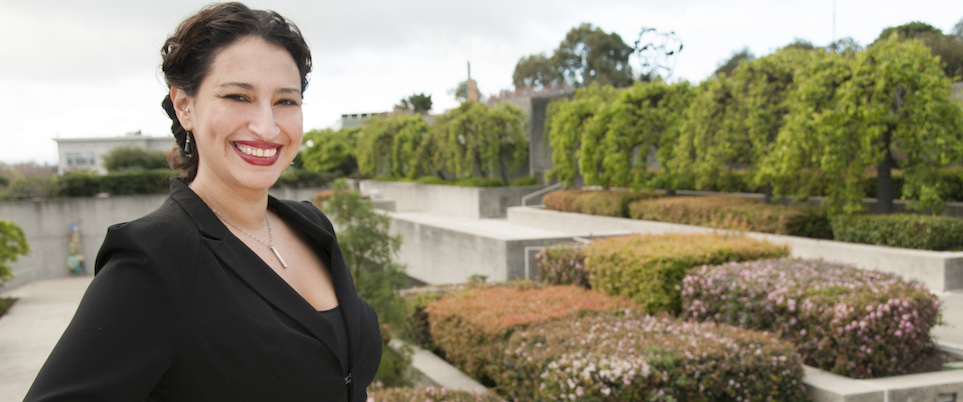When Evelyn Orantes studied history at UC Berkeley, she lived just a few blocks from the Oakland Museum. To her and her roommates the museum seemed as inaccessible as a castle, complete with moat. The Class of ’99 had gotten involved with Chicano politics while at Berkeley, so when she finally went to the museum for its Day of the Dead celebration, it wasn’t to enjoy but to see how OMCA was co-opting the Mexican holiday.
“I came here with a lot of distrust and apprehension about how this big mainstream institution was commodifying our culture, and I was like, ‘Holy crap, I love it,’” Orantes says. “They’d been doing it for 22 years, and Día de los Muertos came here because the community wanted it.”
Orantes, who describes herself as not a person to sit on the sidelines, was so impressed she started volunteering at the museum, and then joined the staff, where she’s been for about 15 years in various jobs. For the last two and a half years she’s been the Curator of Public Practice.
Orantes sees her role as making the museum as egalitarian as possible—reaching out to people like herself, who may think the museum isn’t for them. The job, as well as the title, is fairly new, so Orantes is using her own background and experience to make it up as she goes along.
Orantes says in some ways, it was her experience at Berkeley that led to her current job, where she sees herself as an advocate for social justice as well as a curator.
“The uphill learning curve is really scary,” she says. “There’s no mold to grab on to, but that’s also really liberating.”
Orantes says in some ways, it was her experience at Berkeley that led to her current job, where she sees herself as an advocate for social justice as well as a curator.
“Berkeley gave me the tools to make arguments and articulate ideas,” she says. “I did a year abroad in Spain which really got me thinking about the intersection of art and politics. And why Berkeley appealed to me in the first place was because it was known for the Free Speech Movement and being a politicized place.”
Orantes’s third major show, Oakland, I want you to know… opened July 23rd at the museum and runs through October 30th. Previously, she curated a show with nine local artists in Who Is Oakland? and a project between an Oakland family and artist Maria Mortati, Tell Me Where the Mirrors Go.
For the latest one, she worked with artist and social activist Chris Treggiari to take on gentrification, certainly a hot topic in the city and around the country. The show focuses on West Oakland and the curation re-creates iconic parts of that neighborhood. A Victorian home holds photographs of neighborhood residents and books created by Oakland school kids. A re-creation of Esther’s Orbit Room shows a video about 7th Street as a hub for music, with a musician’s studio in the corner playing Fantastic Negrito’s music. Gardens sprout felt vegetables with information about food deserts and community gardens. In a BART station entrance, you can pick up a phone and hear people’s stories about changes they’ve seen in the neighborhood.

This kind of responsiveness and communication with different groups is why Orantes is so good at her job, says Kelly McKinley, a director at OMCA, who hired her.
“This work runs in her blood,” McKinley says. “She is a natural connector and facilitator, and she has a passion for the work of the museum becoming a gathering place and platform for community expression,”
McKinley says Orantes grew up at the museum and showed her skills at building connections with the community when spearheading its Day of the Dead celebration.
“She worked with professional artists and community groups and school groups to create altars, which were installed across the museum,” she says. “It takes a bold vision to pull off, but also you have to be a superlative project manager and build real trust.”
Orantes likes working with all these different organizations, even if it does mean making quick changes.
“There’s a lot of pivoting,” Orantes says. “I imagine myself like a tai chi practitioner where I get some energy and push it back. There’s a lot of fluidity and constant relationship building.”
Orantes’s skills and her passion for social justice will next be on display in October. For the anniversary of the founding of the Black Panther Party for Self Defense in Oakland, a new exhibit, All Power to the People: Black Panthers at 50, will showcase the movement’s history and legacy.



















